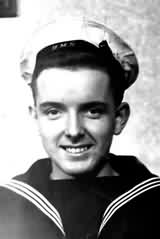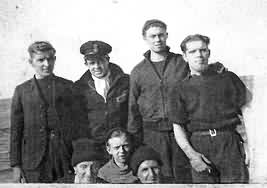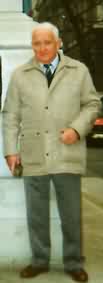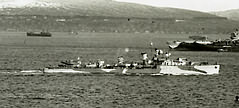|
Survivor
of the sinking
George Walker remembers |
|
 George Walker |
When the war started I was a 19 year old Printers Apprentice, I volunteered in June for the Royal Navy, as an H. O. (hostilities only) at Skegness, after basics I was sent to Chatham for more training, there I went down with Peritonitis so I was in Chatham Hospital for a time and then Dartford for convalescence, I then got three weeks leave just in time for Christmas, then went back to Chatham where my draft had come through to join the Firedrake in Gibraltar. I then had to go to Liverpool and get the troop ship Strathmore which took me to Gibraltar so I finally joined the Firedrake and force H in January 1941. We’d only been on a couple of convoys and on operation ‘Result’ the shelling of the Italian port of Genoa, when we were back in Chatham again, we had ran aground off Spain, lost our ASDIC dome and bent a shaft so were back their for repairs. But we were soon back in the Med again, we then went on operation ‘Substance’ escorting a convoy to Malta we had been attacked by high and low level bombers and managed to keep clear but then we got one that was too close, it blew a massive hole in the starboard side which stopped our engines, we got a tow for part of the way back to Gib, but it was very slow going when we were nearly there the rest of force H passed us on there way back to Gib after delivering the convoy at Malta, all the ships giving us a wave as they went by. |
|
At Gib it was decided that the repairs would have to be done in America, so we had temporary repairs done and off we went to the states. We then pulled into Boston to have the repairs carried out properly. While in America we got looked after very well by the ‘Barons’ friends of the dockyard, people who used to come to the dockyard gates and take you out for the evening to a shows or a party, it was a special scheme they had going at the time for British Servicemen. One family used to pick us up quite regular the Thorpe family, they were very rich Mr Thorpe had a garage so made his money that way, we had some good times there. One night me and Ernie Read had been taken back to there house for a party, just as we were entering the front door we heard the loud voice of the chief, chief petty officer Armstrong the coxswain, we looked at each other and thought we would have to behave our selves now, so we started the night a little bit reserved, but as the night went on we began to relax and we had a very good night we had never been at an occasion with the chief before so we didn’t know what to expect, but he was OK he had a laugh and a joke with us, just like anyone else he was a very sociable bloke. On Christmas Eve me and Charlie Maher were invited to the house again, to there Christmas party, they do things a bit different over there we give our presents out on Christmas morning but they give theirs on Christmas Eve, well we were all having a drink and a chat when Mr Thorpe tossed an envelope to his daughter she opened it to find the log book and keys for a brand new car, just shows you how the other half live, we matelots were on about two shillings and six pence a day that’s twelve and a half pence in new money I think its a bit different today, when at the party two elderly ladies came over to us and told us that they had emigrated from Norwich that’s my home town, after talking for a while I found out that they had lived just six doors away from my house back in Norwich, its a small world and that’s no mistake. |
|
Picture Right:-This photo was taken on Firedrake on one of the convoy Duties, notice we’re in our working clothes, the four standing from left to right first that’s me George Walker, then P.O. Death who also survived the sinking, and then Charlie Maher who went to the Christmas party at the Thorpe’s place in Boston poor Charlie a very nice bloke was lost when Firedrake was sunk in December 42, and Ernie Read who had also been to one of the parties at the Thorpe’s house, he wasn’t on board when Firedrake was sunk he had been transferred to another ship so survived. On the front row kneeling left to right is Jock Christison who was lost, Charlie Ireland who was also lost, and Mack Seddon who survived. |
 |
|
We left Boston in January after having the repairs completed and started work again as leader to B7 escort group working from Londonderry or the UK to Halifax, Nova Scotia or St Johns Newfoundland, Canada or America. On the first convoy from Halifax to Liverpool the ‘Belmont’ another escort destroyer was torpedoed and sunk with the loss of all hands, when me and Charlie Maher were in the railway café back in Derry two girls came over to us and asked if we knew if the ‘Belmont’ had arrived yet because there brother was one board, I just didn’t know what to say so I said I didn’t know, so they went to ask some one else. We did a lot more convoys to Canada and America and we saw a lot of ships go down. |
 |
On
the 12th December 1942, we set out on another convoy across the
Atlantic to Newfoundland we had been at sea for four days and lost
a merchant man every night to the U-boats, so we were on our toes,
also the weather was bad, it had been getting steadily worse and
now had built up to a raging storm. |
|
We couldn’t contact the other escorts because the radio room had also gone, the stokers were trying to shore up the bulkheads, the torpedoes and depth-charges were made safe and jettisoned a group of us made a sea anchor to try and turn the ship out of the heavy seas, the carley floats were dropped over the side and tied to the rails and the guns crew were firing star shells to attract the attention of the other escorts, at about midnight the corvette HMS Sunflower came over to see what was going on, but because the Firedrake was so low in the water and her silhouette so short the skipper thought it was a U-boat on the surface and fired a shot at us luckily it missed, as they got closer they could see what had happened they tried to get close to take the men off but couldn’t get close enough, because of the bad weather, there were now 60 foot waves crashing over the stricken ship so it was decided that the Sunflower would keep circling till day light hoping the weather would improve. At
0045 of the 17th the bulkheads collapsed and Firedrake started to
go under the engineering officer shouted the order to abandon ship,
I jumped over the side and was lucky I landed in a carly float my
mate Charlie didn’t he and Jock Christison grabbed hold of a cork
mat they were being throne all over the place, there were 11 others
with me in the carly float and one in the water hanging on to the
side, at this stage we were still tied to the rail of Firedrake
but we soon got that untied and made our way to the Sunflower. |
| George
Walker and his Wife May, on their wedding day George is wearing
his best uniform the only thing he managed to save from the sinking
Firedrake. The other two photos are of two of George's mates from Norwich who didn't survive the sinking (Centre) Arthur Snelling and (right) Wally Jordan. |
|
Survivor
of the sinking
George S. Wright remembers |
|
 |
I joined HMS Firedrake on or about the 8th December 1942, in Londonderry. As my name begins with the letters WR I was tail end of a draft of about twelve people. The coxswain allotted each man a certain mess so when it came to me there was no more room on the seaman’s mess-deck so I was sent to the torpedo-mans mess and was instructed to do my watches with the torpedo-men. This meant I would do my watch on the quarter-deck with 1 hour in 4 on the bridge as the communications number. |
| We left Londonderry on the 12th December, a decision not very popular with the crew, but we only went as far as Moville where we fuelled. We joined the convoy on the 14th I went on the 1st dog watch (16.00hrs). The coxswain came round during the watch to tell me that my watch had been changed from white to blue and I would therefore do the last Dog watch as well. This change of watch and the fact that I became an ex officio torpeomam were absolutely vital in giving me a chance to get off that ship alive. |
| I
went on watch on the 16th at 20.00hrs, one of the torpedomen had
flu and wanted to keep dry if possible so it was decided that he
should be the communication number on the bridge for the whole of
the watch. The torpedo hit us at about 22.00hrs and at that time
I should have been on the bridge. The bridge and fo’c’sle broke away and drifted off with just the stem sticking out of the water with a light shining from the foremost porthole until it vanished below the waves. We fired a star-shell from the antiaircraft gun, but it jammed, it took almost an hour to free it, then we fired another. The Sunflower found us shortly afterwards. When we abandoned ship I went on a float net which I think are better than carley rafts, they are however impossible to steer and we got on the seaward side of the Sunflower, having passed underneath her bow and back again when returning to the leeward side. I think that was the probably most frightening moment of my life but it only happened once. There was a carley raft following us and they were not so lucky, Donald Coombes and I must have been on the same float (Donald Coombes also a survivor wrote about his experience of drifting under the bows of the Sunflower). The Sunflower was using her search light which I though was extremely brave of them. |
| I
think I was in the water for about 2½ hours before I was hauled
out of the water and landed on the deck of the Sunflower like a
large fish. We then hit the hurricane of 1942 which is still talked
about today which did a lot of damage to the escort ships "Sunflower"
and "Snowflake" lost their Asdic domes the "Pink" lost her radar
and I think the "Alisma" had her bridge smashed. We were landed
at Argentia which was the U.S. base in Newfoundland. We were put into a dormitory which in matters of high comfort and cleanliness belonged to a different millennium to Chatham barracks. After breakfast, the morning after we arrived a young American rating appeared towing a laundry basket filled with cigarettes sweets fruit etc. they’d had a whip round for us in the mess-hall. I worked with the Americans before and after D-day and found them to be a most friendly and generous crowd. Then to St johns by train and passage home aboard HMS Snowflake. |
|
Some
bits of information.
|
| The
U-boat that torpedoed the Firedrake "U211" was herself sunk 430
miles SW of Cape Finisterre by a Wellington fitted with Leigh Light
on 19th November 1943 with No Survivors. The Captain of the Sunflower John Treasure Jones became the captain of the Queen Mary and Commodore of the Cunnard Line. The sole survivor from the forepart of the ship did some quick thinking. He was on the port side when the torpedo hit and realised the ship was breaking up and also realised that he might be swept away on the port side so he went on the starboard side and jumped into the sea there, he was then washed on to the after half of the ship. Survivor, Leading Stoker W. Keenan, later became a C.P.O. but drowned when he fell into the dock at Malta in 1950. Survivor, Able Seaman G.L.W. "Stripy" Seddon rescued two tins of tobacco and his wife’s photograph before leaving the ship. Survivor, Able Seaman Frank S Hougham made sure I was wearing my life belt he said I was going to need it. It was his 3rd sinking. Survivor, Able Seaman Jack Hunter from Glasgow played me at cards on the train to St John’s. |
|
Other
Pages Below
|